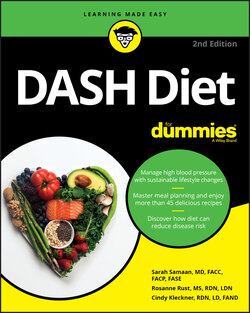Читать книгу DASH Diet For Dummies - Sarah Samaan - Страница 18
The basic dietary guidelines
ОглавлениеEvery type of food included in DASH has a purpose, as you can see from the following list:
Whole grains give you plenty of fiber, potassium, magnesium, and antioxidants, all of which help support the health of your cardiovascular system and lower your blood pressure. A world of difference exists between refined flour and whole-grain flour because after the rough part of the grain is stripped away, most of the nutrients are gone as well. If you need to steer clear of gluten (a protein abundant in wheat, barley, and rye products), you have a variety of interesting whole-grain options to choose from, including quinoa, millet, rice, and oats.
Fruits and vegetables offer blood pressure–friendly nutrients galore, including a wide range of vitamins and antioxidants, plus potassium and fiber. Although whole grains also provide a similar list of healthy elements, the variety supplied by fruits and vegetables is very different. Your body is an incredibly complex system, so you can’t rely on just one category of food to give you everything you need.
Low-fat dairy foods have been strongly linked to a lower risk for hypertension because they’re rich in vitamin D, calcium, magnesium, and potassium; high in protein; and low in saturated fat and calories. There’s also good evidence that dairy foods may reduce the likelihood of stroke, a common complication of high blood pressure. If you’re lactose intolerant, check with your doctor and see whether a lactase supplement may help you enjoy these healthy foods. We provide more pointers on how dairy can fit into your DASH diet in Chapter 11.
Lean meats, fish, and poultry provide plenty of protein to build a healthy and strong body, while limiting your exposure to saturated fats and calories. Although DASH hasn’t been specifically tested in vegetarians, it’s easily adaptable, especially because animal protein is a proportionately smaller part of the plan than it is in a typical Western diet. If you’re a vegetarian, try substituting soy products or other high-protein, vegetable-based options. Of course, nuts and seeds (see the next bullet) also supply some protein. In Chapter 21, we whip up some terrific meat-free recipes to help get you started.
Nuts, seeds, and legumes provide heart-friendly, plant-based protein, along with healthy fats, fiber, and magnesium. Peanuts and soy nuts are, technically speaking, members of the legume family, which also includes beans, chickpeas (found in hummus), and lentils. Although the calories can add up quickly, especially if you’re a nut lover, they come from healthy fats and are a much better choice than typical snack-food fare.
DASH is important not only for the foods it includes but also for those it limits:
Fats and oils are limited but not out of bounds in the DASH diet. Since the time that DASH was developed in the 1990s, more recent research has confirmed the benefit of foods rich in omega-3 fats, such as oily fish, as well as monounsaturated fats like olive oil. A second set of studies known as Omni-Heart confirmed that switching out a small portion (about 10 percent) of carb-based calories and replacing them with healthy monounsaturated fats can make DASH even more effective, as long as the calories remain the same.
Sugary and high-fat treats aren’t forbidden on DASH, but they’re kept to a minimum. If you’re like us, you probably need a little indulgence from time to time. Severely restrictive diets aren’t always realistic and may even cause you to jump ship, giving up on a healthy eating plan altogether. DASH allows you a little leeway to enjoy the foods you love, but don’t be surprised if you find that, after a few days on DASH, you feel so good that snack foods no longer hold the same appeal.
Table 1-1 shows the quantities you should eat of different food groups when following DASH and examples from each group. If what you see here looks a bit basic or maybe kind of daunting, don’t despair. We share more than 40 great-tasting recipes in Part 4 that really make the DASH diet come alive. (Note: The servings listed in Table 1-1 are based on a 2,000-calorie diet. Some people need more calories than that; others need fewer calories.)
TABLE 1-1 The DASH Diet (Based on 2,000 Calories/Day)
| Type of Food | Number of Servings for a 2,000-Calorie Diet | Example Serving Sizes |
|---|---|---|
| Grains and grain products | 6–8 per day | 1 slice bread, 1 cup dry cereal, ½ cup cooked cereal, rice, or pasta |
| Fruits | 4–5 per day | 10 grapes, ½ grapefruit, 1 small banana, 2 tablespoons raisins, 1 medium apple |
| Vegetables | 4–5 per day | 1 cup raw, ½ cup cooked |
| Low-fat or nonfat dairy products | 2–3 per day | 1 cup milk or yogurt, 1 ounce cheese |
| Lean meats, fish, poultry | 2 or fewer per day | 3–4 ounces cooked per day |
| Nuts, seeds, legumes | 4–5 per week | 1/3 cup nuts, 2 tablespoons nut butter, 2 tablespoons seeds |
| Fats and oils | 3–4 per day | 1 teaspoon margarine, butter, or oil; 2 tablespoons salad dressing |
| High-fat/high-sugar extras | 5 or fewer per week | ½ cup sorbet or frozen yogurt, 1 “fun-size” candy bar, 8 pieces of gummy-type candy, 1 tablespoon jam; 1 ounce dark chocolate (70 percent to 85 percent cocoa) |
That’s the DASH diet in a nutshell; for a deeper look at DASH nutrition, see Chapter 5.
By choosing DASH, you’ll achieve better blood pressure deliciously. And with such a wide range of foods to choose from, it’s easy to see how you can tailor DASH to your personal taste.
